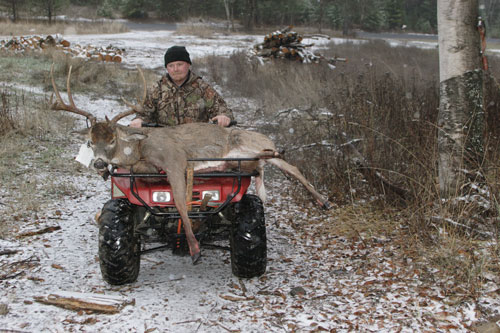 The bow season is about to close, and you still have an un-punched buck tag in your pocket. As the eleventh hour approaches, you either pull out all the stops or go home empty-handed. What can you do? Three successful non-professional hunters—Wayne Merritt, Jon Kayser, and Doug Turnbull— let us in on their proven last-minute tactics.
The bow season is about to close, and you still have an un-punched buck tag in your pocket. As the eleventh hour approaches, you either pull out all the stops or go home empty-handed. What can you do? Three successful non-professional hunters—Wayne Merritt, Jon Kayser, and Doug Turnbull— let us in on their proven last-minute tactics.
1. Go to the Suburbs
Bow mechanic Wayne Merritt fixes compounds, but prefers to hunt with traditional equipment.
“When it comes down to the wire, I look for racked bucks to be holed up in strips of cover behind housing projects and wooded areas adjacent to commercial buildings,” said Merritt. “Deer are generally pushed here by the hordes of gun hunters who cannot gain access because of safety issues. Polite bowhunters, however, are often granted permission. In fact, many of these developments are bow-only areas mandated by law.
“Cover is paramount, so I look for bucks to be hiding in small patches of brush, stands of Christmas trees, or even a wooded slope just off the highway. They have to eat somewhere, and often that means cornfields and alfalfa lots on nearby farms. I look for trails leading out of suburbia, such as creek beds, property fence lines, and overgrown foot paths, and set up along those exit routes as close to the bedding areas as possible.
“You will find that most of the action will be late in the afternoon,” added Merritt, “but a morning ambush can still pay off if you set up close to the bedding area and are on stand well before pink light. I have found that the better bucks head for security cover at the first hint of dawn.”
2. Sit Your Wilderness Stand All Day
Foresters and independent loggers like Jon Kayser spend hours and hours in the woods, allowing them to keep tabs on local deer populations. “Wilderness bucks are few and far between,” admitted Kayser, “but being in the woods every day has taught me that the very best time to arrow a book deer is after the rut and near the end of the season. As the rut draws down to a close, mature bucks begin traveling more and more to hook up with one of the last unbred does. Generally nocturnal, racked bucks you never knew existed before will suddenly appear during daylight hours near traditional doe bedding and feeding areas. Indeed, it is not unusual for a mature buck to cover 15 or 20 miles at this time in the hopes of connecting with an estrous doe.
“I rarely encounter another bowhunter at this time of the year,” Kayser added. “My plan is to set up a treestand downwind of known doe bedding and feeding areas, and hunt all day long. I know that sooner or later a hat-rack buck will likely stroll into view, giving me at least one more chance to fill my tag.”
3. Do Not Stop Practicing!
Doug Turnbull’s business does not allow him to bowhunt the early season on through the peak of the rut as often as he would like.
“The cold temperatures and months of not shooting my bow will dull my shooting skills. Unless bowhunters shoot regularly during the season, the odds of a missing a buck during the closing days of the season are high,” said Turnbull. "Not only is our accuracy in doubt, but the ability to come to full draw in cold weather while wearing bulky clothing can be a challenge unto itself. And I can tell you from personal experience that there is nothing more disheartening than to finally have a good buck walk under your stand, and find that you just cannot get your bow back to take a shot.”






